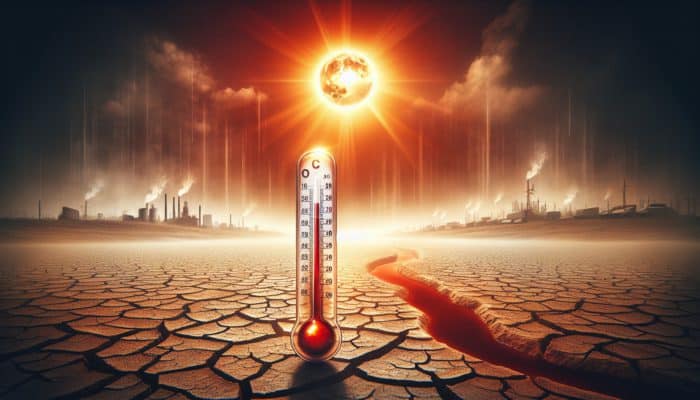Comprehensive Insights into Drought Conditions and Their Consequences
Understanding the Key Drivers Behind Drought Phenomena

Droughts result from a complex interaction between both natural and anthropogenic factors. The predominant trigger is usually a significant decline in precipitation, yet the severity of droughts is often exacerbated by additional influences such as climate change, escalating temperatures, and increased water demands across various sectors including agriculture and urban development. A thorough comprehension of these causal factors is crucial for devising proactive measures and efficient mitigation strategies. The prevalent contributors to drought conditions include:
- Prolonged periods of low rainfall
- Escalating temperatures and extreme heatwaves
- Increased water consumption due to agricultural and urban activities
- Climate variability and unpredictable weather patterns
- Deforestation and the resulting land degradation
- Excessive extraction of groundwater resources
- Weather phenomena such as El Niño
- Soil degradation that impairs moisture retention
When these factors intersect, specific regions may face acute droughts that persist for prolonged periods, sometimes spanning months or even years. Recognising these triggers enables communities and governments to develop strategies that enhance effective responses and build resilience against future drought occurrences.
Assessing the Impact of Drought on Water Supply Availability
The ramifications of drought on water supply are extensive and significant. During drought conditions, the availability of freshwater resources diminishes sharply, adversely impacting agricultural productivity, the accessibility of drinking water, and the overall health of ecological systems. Households commonly face restrictions on water usage, while farmers struggle with reduced crop yields, resulting in heightened food insecurity. Gaining a thorough understanding of these implications is essential for sustainable water resource management. For example, as reservoirs and aquifers begin to deplete, urban areas may encounter intensified competition for limited water resources, leading to increased costs and potential disputes over water rights. To effectively adapt to these challenges, communities must prioritise robust water conservation and management strategies that assure long-term sustainability.
Effective Monitoring of Drought Indicators for Proactive Management
Successful drought management is heavily reliant on the ongoing monitoring of various indicators that signal the onset and intensity of drought conditions. Key indicators include soil moisture levels, historical rainfall patterns, and the status of local reservoirs. By examining these critical metrics, communities can foresee drought risks and implement timely interventions. For instance, advanced satellite technology now enables real-time monitoring of soil moisture, providing invaluable information to farmers and policymakers alike. This proactive strategy allows for improved resource allocation and ensures that communities can respond swiftly and efficiently to rising water shortages, ultimately enhancing their resilience against drought conditions.
Strategic Approaches to Flourish During Drought Conditions

Implementing Effective Water Conservation Practices for Sustainability
Embracing water conservation measures during drought periods is vital for ensuring sustainability and enhancing community resilience. Both households and businesses can adopt a variety of best practices aimed at significantly curtailing their water consumption. Effective techniques include reducing shower durations, promptly repairing leaks, utilising water-efficient appliances, and installing rainwater harvesting systems. Moreover, repurposing greywater for non-potable applications can drastically lower the demand on freshwater supplies. Noteworthy real-world examples, such as the implementation of greywater systems in urban centres like Los Angeles, highlight the potential for substantial water savings. By collectively adopting these practices, communities can effectively lessen the impacts of drought and improve their overall water security.
Strategic Community Preparations for Anticipated Drought Conditions
Communities must proactively prepare for potential drought conditions by executing strategic measures. Formulating comprehensive contingency plans that delineate specific actions to be taken during water shortages is crucial. Essential strategies include educating residents about effective water conservation techniques, enacting policies that encourage water-saving behaviours, and investing in necessary infrastructure for water storage, such as reservoirs and cisterns. Moreover, establishing local water committees can oversee water usage and judicious management of resources. Engaging residents in water conservation initiatives cultivates a sense of shared responsibility regarding resource management, ensuring that every individual plays a pivotal role in minimising water consumption during dry periods.
The Role of Governments in Effective Drought Management and Response
Governments hold a pivotal responsibility in managing drought through the development of comprehensive policies and investments in water-related projects. By allocating funds for innovative water conservation technologies and infrastructure development, governments can empower communities to enhance their resilience against drought conditions. Furthermore, they can implement regulations that advocate for sustainable water usage practices and support research into drought-resistant crops. Additionally, governments play an essential role in coordinating emergency responses, providing financial assistance to affected regions, and ensuring equitable distribution of water resources. A well-structured and responsive governmental approach can significantly mitigate the adverse impacts of drought on both communities and ecosystems, ultimately fostering long-term resilience.
Innovative Techniques for Effective Water Conservation
Maximising Rainwater Harvesting Systems for Sustainable Usage
Rainwater harvesting systems are essential for reducing reliance on conventional water supplies, particularly during drought periods. These systems enable households and communities to capture, store, and utilise rainwater for various non-potable applications. Establishing a rainwater harvesting system involves several critical steps:
- Identify suitable catchment areas, such as rooftops, that can effectively collect rainwater.
- Install gutters and downspouts to channel rainwater into storage tanks.
- Select storage containers that comply with health and safety standards to ensure water quality.
- Incorporate filtration systems to maintain the purity of the stored water.
- Implement a distribution framework for employing harvested water in gardens and irrigation.
- Regularly maintain and clean the system to avert contamination.
- Educate users on best practices for the safe use of harvested water.
By capturing rainwater, communities can significantly augment their water supplies, especially during crucial dry spells, thereby enhancing their resilience to drought and mitigating its adverse effects.
Utilising Efficient Irrigation Techniques to Maximise Water Use During Drought
Adopting efficient irrigation methodologies during drought conditions is critical for optimising water use while ensuring the health of crops. Techniques such as drip irrigation, which delivers water directly to the roots of plants, significantly reduce evaporation and runoff. Additionally, mulching serves as another effective strategy, as it helps retain moisture in the soil and decreases the necessity for additional watering. For example, farmers in regions like the Middle East have successfully implemented drip irrigation systems to cultivate crops with notably lower water consumption. These methods not only conserve water but also enhance crop yield and quality, thus ensuring food security during challenging climatic conditions.
Repurposing Greywater for Non-Potable Applications
Utilising greywater—wastewater from baths, sinks, and laundry—for non-potable applications is an effective strategy for conserving freshwater during drought periods. Households can collect this water and repurpose it for irrigation, toilet flushing, or cleaning tasks. Implementing greywater systems involves several important steps:
- Identify sources of greywater, ensuring they are devoid of harmful chemicals.
- Install a greywater collection system that separates it from blackwater.
- Employ appropriate filtration and treatment methods to enhance water quality.
- Educate household members on safe practices for greywater usage.
- Regularly monitor systems to prevent blockages and contamination.
By integrating greywater systems into daily practices, households can significantly reduce their reliance on freshwater supplies, particularly during drought conditions, thus contributing to broader water conservation initiatives.
Advancements in Drought-Resistant Agricultural Practices
Critical Factors in Selecting Drought-Tolerant Crop Varieties
Choosing drought-tolerant crops is a fundamental strategy for sustaining agricultural productivity in regions susceptible to drought. These crops are specifically bred or selected for their ability to withstand low moisture conditions. Examples include millets, sorghum, and certain varieties of beans that require significantly less water than conventional crops. Farmers can also benefit from cultivating native plants that are adapted to local climates, often exhibiting lower water requirements. By making informed crop selections, farmers can enhance their resilience to drought while ensuring food security for communities during periods of water scarcity.
Soil Management Practices to Enhance Drought Resilience
Effective soil management is crucial for boosting agricultural resilience to drought. Practices such as incorporating organic matter, including compost and mulch, improve soil structure and moisture retention capabilities. Employing cover cropping can further enhance soil health, preventing erosion and maintaining moisture levels. Techniques like reduced tillage help to preserve soil integrity and minimise disruption, allowing water to penetrate the soil more effectively. For instance, farmers in regions such as Southern Africa have adopted these practices, resulting in improved soil conditions and enhanced resilience against prolonged dry spells. By prioritising soil health, agricultural productivity can be sustained even amid adverse climatic conditions.
The Benefits of Crop Rotation in Drought Conditions
Crop rotation is a well-established agricultural practice that offers numerous advantages, especially in drought-prone areas. By alternating the types of crops planted in a specific field, farmers can improve soil structure and fertility while enhancing moisture retention and soil quality. This approach helps disrupt pest and disease cycles, thereby reducing reliance on chemical inputs. Moreover, certain crops can enrich soil nutrients, benefiting subsequent crops during dry spells. For example, incorporating legumes can infuse nitrogen into the soil, enabling other crops to thrive with less water. Implementing crop rotation can establish more resilient farming systems that are better equipped to endure the challenges posed by drought conditions.
Implementing Efficient Irrigation Systems for Sustainable Agricultural Practices
Adopting efficient irrigation systems is essential for conserving water and ensuring agricultural sustainability during drought periods. Techniques such as drip irrigation and sprinkler systems, which deliver water directly to the plant roots, can dramatically reduce water consumption. For instance, farmers in California have reported significant water savings and increased yields by utilising drip irrigation methods. Additionally, integrating smart irrigation technologies equipped with soil moisture sensors can optimise watering schedules based on real-time data, minimising waste. These innovations not only assist in conserving water but also enhance crop health, ensuring that food production continues even in arid conditions.
Proven Strategies for Enduring Drought Challenges
Practical Steps Households Can Take to Reduce Water Usage
Households can adopt several practical measures to significantly decrease water usage during drought conditions. Simple actions, such as promptly repairing leaks, installing low-flow fixtures, and selecting water-efficient appliances, can yield substantial water savings. Furthermore, households should consider adapting daily habits, such as taking shorter showers and turning off the tap while brushing their teeth. Some practical tips for effective water conservation include:
- Install rain barrels to collect rainwater for outdoor usage.
- Utilise a broom instead of a hose for cleaning driveways.
- Run dishwashers and washing machines only with full loads.
- Limit irrigation to early mornings or late evenings to reduce evaporation.
- Use mulch in gardens to help retain soil moisture.
- Educate family members about the significance of water conservation.
- Select drought-resistant landscaping to minimise water usage.
By collectively embracing these strategies, households can make a significant contribution to water conservation efforts during drought conditions, thereby promoting a sustainable future for all.
Long-Term Solutions for Effectively Addressing Drought Challenges
Long-term solutions to drought necessitate a multifaceted approach that integrates technological, infrastructural, and behavioural changes. Investing in desalination plants can establish a reliable freshwater source, particularly for coastal communities. Furthermore, enhancing existing water infrastructure to reduce leaks and improve distribution efficiency is essential. Promoting sustainable water usage practices, such as regulating groundwater extraction and incentivising conservation measures, can also reinforce resilience to future droughts. For example, regions that have enacted integrated water resource management strategies have observed improved outcomes in water availability and community preparedness, cultivating a culture of sustainability and proactive management.
Key Components of Community-Based Drought Response Plans
Community-based drought response plans are imperative for effective water resource management during drought periods. Such plans require collaboration among local organisations, residents, and authorities to ensure a coordinated approach to water conservation and resource allocation. Key components of these plans include developing emergency response strategies, establishing communication protocols, and identifying critical water needs across various sectors. Engaging residents in the planning and decision-making processes fosters a sense of ownership and accountability regarding water resources. Communities that have successfully implemented these plans have demonstrated enhanced resilience and adaptability in the face of prolonged drought conditions, ensuring that resources are managed effectively.
The Consequences of Drought on Wildlife Populations
Understanding the Impact of Drought on Wildlife Populations
Drought significantly affects wildlife by diminishing the availability of critical food and water resources. As habitats become increasingly arid, many species struggle to find adequate sustenance, leading to stress and potential population declines. For instance, herbivores may encounter challenges due to a lack of forage, while predators struggle to hunt for prey. Recognising these impacts is vital for conservation efforts, as species may be compelled to migrate to new areas in search of resources. Wildlife conservationists must closely monitor these changes to develop strategies that effectively mitigate the adverse effects of drought on vulnerable populations and preserve biodiversity.
Strategies for Protecting Wildlife During Drought Conditions
Safeguarding wildlife during drought necessitates a combination of habitat management and the provision of alternative water sources. Establishing waterholes or artificial ponds can create essential hydration points for animals during dry spells. Additionally, managing habitats to foster biodiversity can enhance ecosystem resilience. For example, sustaining native vegetation can support wildlife by providing vital food and shelter. Implementing conservation programmes focused on protecting key species is also critical for ensuring their survival throughout drought conditions. Collaborative efforts among conservation organisations and local communities are essential for the effective implementation of these protective strategies, ultimately supporting wildlife health and ecosystem balance.
The Role of Wildlife Reserves in Drought Management
Wildlife reserves play a crucial role in drought management by serving as sanctuaries for diverse species. During dry periods, these reserves offer vital habitats and water sources, ensuring the survival of wildlife populations. They also function as conservation areas where ecosystems can be monitored and managed to enhance their resilience and sustainability. For instance, reserves often implement controlled burns and habitat restoration projects that promote biodiversity and improve water retention within the landscape. By prioritising conservation efforts within these areas, wildlife reserves can significantly mitigate the impacts of drought on animal populations and contribute to overall ecosystem health.
How Drought Influences Wildlife Migration Patterns
Drought can disrupt established migration routes and timings for wildlife, adversely affecting their survival and reproductive success. As water sources dwindle, animals may be forced to migrate greater distances in search of food and hydration, thus altering their traditional patterns. For instance, migratory birds might arrive at breeding grounds too late due to delays in food availability, leading to decreased survival rates of their offspring. Tracking these changes is essential for effective conservation strategies, as understanding migration dynamics can inform habitat protection measures and guide species management initiatives, thereby enhancing the long-term survival of wildlife.
Long-Term Effects of Drought on Wildlife Populations
Prolonged droughts can result in substantial declines in wildlife populations and biodiversity loss, leading to cascading effects on entire ecosystems. Species that cannot adapt to changing conditions may face extinction, particularly those with specialised habitat requirements. Continuous long-term studies are necessary to fully comprehend these impacts and devise effective conservation strategies. For example, researchers may monitor population dynamics over several years to evaluate the resilience of species in drought-prone areas. By identifying vulnerable populations, conservationists can implement targeted initiatives to enhance their survival and promote ecosystem health amidst ongoing challenges.
Economic Impacts of Drought
Assessing the Economic Impact of Drought on Agricultural Sectors
Drought can severely disrupt agricultural economies, leading to diminished crop yields and increased operational costs for farmers. The scarcity of water directly affects crop growth and health, resulting in lower harvests and potentially prompting food shortages. Livestock also suffers as reduced forage availability escalates feed costs and leads to animal losses. Understanding these economic repercussions is essential for formulating effective recovery plans that support farmers and alleviate their losses. For instance, regions that have experienced severe droughts often observe a ripple effect on local businesses reliant on agriculture, necessitating targeted interventions to stabilise the economy.
The Impact of Drought on Water-Intensive Industries
Industries that rely heavily on water, such as manufacturing and energy production, encounter substantial challenges during droughts. Water scarcity can lead to operational disruptions and heightened production costs. For instance, power plants that depend on water for cooling may need to reduce their output, resulting in energy supply shortages. As these industries adapt to such challenges, they may invest in water-saving technologies or shift to alternative production methods. Understanding these impacts is crucial for policymakers to support affected sectors and promote economic resilience in the face of recurring drought conditions, ensuring long-term stability.
Strategies to Enhance Economic Resilience During Drought Events
Building economic resilience during drought necessitates diversifying income sources and investing in drought-resistant technologies. Farmers can adopt practices that enhance water efficiency and crop resilience, such as precision agriculture and sustainable farming methods. Additionally, creating financial safety nets, including crop insurance and subsidies, can provide a buffer against economic losses. Governments play a crucial role in facilitating access to necessary resources and support for businesses affected by drought. Communities that proactively invest in innovation and education are more likely to thrive, even amidst challenging climatic conditions, thereby ensuring long-term sustainability and economic health.
Effective Economic Policy Responses During Drought Conditions
Governments can enact a variety of policy responses to mitigate the economic impacts of drought on affected sectors. Strategies may include providing subsidies to farmers for water-efficient technologies, offering tax relief to businesses facing losses, and establishing emergency funds to assist communities in crisis. Policymakers must consider long-term strategies that promote sustainable water management and enhance resilience to drought. By adopting a proactive approach to policy development, governments can stabilise local economies and support recovery efforts during challenging times for agriculture and industry, ultimately fostering community resilience.
Frequently Asked Questions About Drought Management
What are the primary causes of drought?
Droughts primarily arise from extended periods of low rainfall, elevated temperatures, increased water demand, and the overarching influences of climate change. Understanding these causes is vital for effective preparation and mitigation of drought conditions.
How can I conserve water at home during a drought?
You can conserve water by promptly repairing leaks, installing low-flow fixtures, taking shorter showers, and using efficient appliances. Additionally, consider implementing rainwater harvesting and repurposing greywater for irrigation purposes to maximise water use.
What are the best irrigation methods during drought conditions?
Efficient irrigation methods like drip irrigation and mulching are highly effective during droughts, as they minimise water waste while preserving crop health and productivity, ensuring sustainable agricultural practices.
How does drought impact wildlife?
Drought leads to diminished food and water availability for wildlife, resulting in stress, potential migration, and declines in population numbers. Understanding these effects is critical for conservation efforts aimed at protecting vulnerable species from the impacts of drought.
What role do governments play in managing drought?
Governments manage drought through policy-making, funding water projects, supporting agricultural resilience, and providing emergency relief to affected regions, enabling communities to better cope with the challenges posed by drought conditions.
How can communities prepare for droughts?
Communities can prepare for drought by developing comprehensive contingency plans, educating residents about water conservation, investing in vital infrastructure, and forming local water committees to manage resources efficiently and sustainably.
What are the long-term solutions to drought?
Long-term solutions to drought include investments in desalination plants, improvements to existing water infrastructure, and the promotion of sustainable water practices, all aimed at enhancing resilience against future drought events.
What is rainwater harvesting, and how can it assist during drought?
Rainwater harvesting is the practice of capturing and storing rainwater for later use, reducing reliance on traditional water sources and providing an alternative supply during drought conditions, which enhances overall water security and resilience.
How does drought impact agricultural economies?
Droughts result in reduced crop yields and increased operational costs for farmers, leading to economic instability within agricultural economies and affecting associated businesses reliant on agricultural productivity and stability.
What are effective strategies for protecting wildlife during drought?
Effective strategies include creating alternative water sources, managing habitats to promote biodiversity, and implementing conservation programmes aimed at supporting wildlife during dry periods, ensuring their survival and ecological balance.
Explore our world on X!
The post Surviving a Drought: Essential Strategies appeared first on Survival Bite.
The Article Essential Strategies for Surviving a Drought Was Found On https://limitsofstrategy.com

